Your Call?
Which of today’s eight featured images do you like best? Why?
What’s Up?
As you will see below, Friday past was not a bad day in the middle of Florida. On Saturday at Circle B Bar the Barred Owl nest was pretty good in the morning. Story below. And I just missed on a cooperative male Painted Bunting. A small limb covered with Spanish Moss broke off a tree in the high wind and came crashing down, just missing the bunting by inches. The bird flew off and was never seen again. Sunday morning, on the other hand, was terrible. One of the baby owls came out of the nest hole briefly and then disappeared for the rest of the morning. Sunday afternoon, however, was fantastic as the two baby owls posed next to each other in the nest hole. Most of the photographers had left much too early.
If you own a copy of The Middle of Florida Photographic Site Guide — info below, or purchase one today, shoot me an e-mail with proof off purchase and type Circle B Bar Barred Owl Nest Details Please into the subject line.
Today is Monday 25 March. This blog post took well more than five hours to create. I am heading early to Stick Marsh. Wherever you are and whatever you are doing, I hope that you too have a wonderfully happy day. Downloading and pick my keepers took less than a minute.
If you plan on purchasing a Sony a9 III Mirrorless Camera (or anything else for that matter), please remember to use or write for either my Bedfords discount code or my B&H affiliate link. Folks who use one of my two affiliate links to purchase the a9 III will receive my .DAT settings (the complete camera set-up) along with a Buttons and Dials Guide.
If you would like to enjoy some incredible world class photography and photographic instruction, do yourself a favor and grab one of the few remaining spots on the t2025 Homer Bald Eagle IPTs. Better yet, save $1000.00 by signing up for both! It will almost surely be my last ever Homer trip … Both trips will surely fill soon. See the details along with all IPT info on the recently updated page here.
Please remember to use the B&H links that are found on most blog pages and to use the BIRDSASART discount code at checkout when purchasing your new gear from Bedfords to get 3% back on your credit card and enjoy free second-day air FedEx. Please, also, consider joining a BAA IPT. You will be amazed at how much you will learn!
If an item — a Delkin flash card, or a tripod head — for example, that is available from B&H and/or Bedfords, is also available in the BAA Online Store, it would be great, and greatly appreciated, if you would opt to purchase from us. We will match any price. Please remember also to use my B&H affiliate links or to earn 3% cash back at Bedfords by using the BIRDSASART discount code at checkout for your major gear purchases. Doing either often earns you free guides and/or discounts. And always earns my great appreciation.
Save 15%!
If you’d like to try out a new lens or if you need a lens for a specific trip or project (or for an IPT), LensRentals.com is the only way to go. To save 15%, simply click on the logo link above, arrange for your rental, and type in BIRDSASART15. If you type the gear you are looking for in the search box, it will pop right up. LensRentals.com offers affordable insurance. You can decline it, opt for LensCap: Damage Only, or select LensCap: Damage & Theft. Then hit PROCEED TO CHECKOUT. After you enter all of your info but before completing your order, be sure to scroll down to Promo Code box and enter the BIRDSASART15 code to save 15%.
I checked on renting a Sony FE 70-200mm f/2.8 GM OSS II lens for a week. The cost is only $122.00. LensCap: Damage Only coverage can be added for a very low $18.00. Going with LensCap: Damage & Theft would be $27.00. The shipping charge varies. They offer an interesting program called Lensrentals HD. By signing up for this shipping discount program ($99.00/year), you’ll get free Standard Shipping on all the orders you place.
Renting a Sony 600mm f/4 GM OSS lens for a week will cost you $536.00. The two coverage options come in at $76.00 or $114.00. Less your 15% discount when you enter the BIRDSASART15 code into the Promo Code box at checkout and enter the BIRDSASART15 code in the Promo Code box at checkout to save 15%.
Remember, to save the 15% on your rental you must start your search by clicking on the logo above, or on this link: LensRentals.com


B&H
To ensure that I get credit for your B&H purchases, you can always click here. The tracking is invisible but greatly appreciated. And, you can use your PayBoo card. You must use the website to order. B&H will reopen on Fri April 14. Thanking me for the past 4000 educational blog posts could not be any easier and will not cost you one penny. Please shoot me your B&H receipt for major purchases.
Many folks have written recently stating that they purchased a Sony a1 from B&H and would like their free membership in the Sony 1 Info and Updates Group, a $150.00 value. When I check my affiliate account, their orders have not been there. When I let them know that they get credit for B&H purchases only if they use one of the many B&H affiliate links on the blog or begin their searches with this link, they are always disappointed. If in doubt, please contact me via e-mail and request a BH link. I am always glad to help and to guide you to the right gear.
Bedfords Simplified
Click here to start your search. Choose standard shipping, and when you get to the payment page, enter BIRDSASART in the discount code box and hit apply. You will be upgraded to free second day air Fed-Ex and receive 3% cash back on your credit card once your stuff ships. Either is greatly appreciated by yours truly.
Bedfords Amazing BAA Discount Policy
Folks who have fallen in love with Bedfords can now use the BIRDSASART coupon code at checkout to enjoy a post-purchase, 3% off-statement credit (excluding taxes and shipping charges) on orders paid with a credit card. The 3% credit will be refunded to the card you used for your purchase. Be sure, also, to check the box for free shipping to enjoy free Second Day Air Fed-Ex. This offer does not apply to purchases of Classes, Gift Cards, prior purchases.
Visit the Bedfords website here, shoot Steve Elkins an e-mail, or text him on his cell phone at (479) 381-2592.
Gear Questions and Advice
Too many folks attending BAA IPTs and dozens of photographers whom I see in the field and on BPN, are — out of ignorance — using the wrong gear, especially when it comes to tripods and more especially, tripod heads. And the same is true in spades when ordering new camera bodies or lenses. My advice will often stave you some serious money and may help you avoid making a seriously bad choice. Please know that I am always glad to answer your gear questions via e-mail. If you are desperate, you can try me on my cell at 863-221-2372. Please leave a message and shoot me a text if I do not pick up.
|
|
|
This image was created on 22 March 2024 down by the lake near my home at Indian Lake Estates, FL. Standing at full height on the South Peninsula I used the handheld Sony FE 300mm f/2.8 GM OSS Lens (Sony E) and the ridiculously amazing Sony a9 III Mirrorless Camera. The exposure was determined via Zebra technology with ISO on the Thumb Dial. ISO 1250: 1/1250 sec. at f/4 (stopped down one stop) in Manual mode. When evaluated in RawDigger, the raw file brightness was determined to be perfect. AWB at 9:00:06am on a cloudy morning. Tracking: Expand Spot/AF-C with Bird Face/Eye detection enabled performed to perfection. Be sure to click on the image to enjoy the high-res version. Image #1: Sandhill Crane adult flapping in place |
The Forecast
The March 22nd forecast for Indian Lake Estates, for Fellsmere, for St. Petersburg, for Lakeland, and for Fort Lauderdale, was for rain all day. It was pouring at ILE at 4:45am so I went back to bed. A bit after eight, the rain quit so I headed down to the lake near my home and did not find much but the single crane above. When it flapped in place, I followed my own advice and pushed the shutter button.
I spoke to Claudia and David, a neighborhood couple who live at the north end of Palmetto Drive. We were discussing the dearth of baby cranes at ILE this year. Claudia mentioned that she had a friend across the lake who had a pair with two small chicks. I texted Cindy and Kevin Stenzel who kindly directed me to the crane family below. And showed me some photos of a baby Barred Owl and kindly directed me to the location of the nest tree in Circle B Bar (below). Huge thanks to the Stenzel’s for setting up what turned out to be a great day!
|
|
|
This image was created on 22 March 2024 at Walden Shores, Lake Wales. Seated on a grassy field, I used the lowered Robus RC-5558 Vantage Series 3 Carbon Fiber Tripod/Levered-Clamp FlexShooter Pro-mounted Sony FE 600mm f/4 GM OSS lens and the ridiculously amazing Sony a9 III Mirrorless Camera. ISO 1600. Exposure was determined via Zebras with ISO on the rear dial: 1/1000 sec. at f/4 (wide open). AWB at 1:04:54pm on cloudy afternoon. Tracking: Zone/AF-C with Bird Face-Eye detection enabled was active at the moment of exposure and performed perfectly. Be sure to click on the image to enjoy the larger version. Image #2: Sandhill Crane chick reaching up to parent or tidbit. |
a9 iii Tracking Zone AF-C with Bird Face-Eye Detection Enabled
My gut feeling is that a9 iii Tracking Zone AF-C with Bird Face-Eye detection enabled performs even better than it does with the Sony a1. With the baby cranes running around between the parent’s legs and begging to get fed, the tiny box grabbed the chick’s eye and stuck to it like glue. Getting a pleasing image design is, however, up to the photographer.
|
|
|
This image was also created on 22 March 2024 at Walden Shores, Lake Wales. While standing at full height, Seated on a grassy field, I used the lowered Robus RC-5558 Vantage Series 3 Carbon Fiber Tripod/Levered-Clamp FlexShooter Pro-mounted Sony FE 600mm f/4 GM OSS lens and the ridiculously amazing Sony a9 III Mirrorless Camera. ISO 2000. Exposure was determined via Zebras with ISO on the rear dial: 1/1250 sec. at f/4 (wide open). AWB at 1:17:57pm on cloudy afternoon. Tracking: Zone/AF-C with Bird Face-Eye detection enabled was active at the moment of exposure and performed perfectly. Be sure to click on the image to enjoy the larger version. Image #3: Sandhill Crane adult with tiny snail for chick partially hidden in flowers |
Add Flowers Whenever Possible
As the cranes made their way up the shoreline to my left, I moved along with them while keeping the wind behind me. The clouds were a blessing as there were no light angle concerns. When I saw the small stand of flowers along the edge of the pond, I moved again and hoped that the chick behind the flowers would raise its head so that it was no longer obscured. Almost.
|
|
|
This image was also created on 22 March 2024 at Walden Shores, Lake Wales. Seated on a grassy field, I used the flattened Robus RC-5558 Vantage Series 3 Carbon Fiber Tripod/Levered-Clamp FlexShooter Pro-mounted Sony FE 600mm f/4 GM OSS lens and the ridiculously amazing Sony a9 III Mirrorless Camera. ISO 2000. Exposure was determined via Zebras with ISO on the rear dial: 1/1000 sec. at f/4 (wide open). AWB at 1:21:14pm on cloudy afternoon. Tracking: Zone/AF-C with Bird Face-Eye detection enabled was active at the moment of exposure and performed perfectly. Be sure to click on the image to enjoy the larger version. Image #4: Sandhill Crane chick posing |
Simple Portrait
Even when creating a simple portrait, with Bird Face-Eye detection enabled nailed the chick’s eye every time. To create this more intimate image, I flattened the tripod and worked off the rear screen of the a9 iii. I still need to put some time in to figure out how to use that screen vertically.
|
|
|
This image was created on 22 March 2024 in Eloise, FL. Standing at full height, I used the handheld Sony FE 300mm f/2.8 GM OSS Lens (Sony E) with the Sony FE 1.4x Teleconverter and the ridiculously amazing Sony a9 III Mirrorless Camera. The exposure was determined via Zebra technology with ISO on the Thumb Dial. ISO 1000: 1/3200 sec. at f/4.5 (stopped down 1/3 stop by accident) in Manual mode. When evaluated in RawDigger, the raw file brightness was determined to be dead solid perfect. AWB at 2:55:30am on then party sunny afternoon. Tracking: Zone/AF-C with Bird Face/Eye detection enabled performed well. Be sure to click on the image to enjoy a high-res version. Image #5: Roseate Spoonbill and Tricolored Heron |
Only in Florida
Immediately after driving by a collision shop I passed by a winding creek with too much trash in it. In addition to a variety of soda cans and bottles and empty cigarette packs were a handsome Roseate Spoonbill and a pretty spiffy Tricolored Heron, both in rather nice breeding plumage. I hung a U-turn, pulled off the road, grabbed the 300mm/a9 iii rig, added the 1.4X TC, crossed the busy road carefully, crossed the stream, headed down the bank to get more on the bird’s level, and went to work. I was somewhat shocked to have made even a single decent photo.
|
|
|
This image was also created on 22 March 2024, these next few at Circle B Bar Reserve. Standing at full height I used the ultra tall owl tripod, the Robus RC-5570 Vantage Series 3 Carbon Fiber Tripod topped by a Levered-Clamp FlexShooter Pro with the Sony FE 600mm f/4 GM OSS lens and The One, the Sony Alpha 1 Mirrorless Digital Camera.. ISO 2000. The exposure was determined by Zebras with ISO on the rear wheel: 1/500 second at f/4 (wide open) in Manual mode. RawDigger showed that the exposure was perfect. AWB at 8:37:29am on sunny morning with just a bit of haze in front of the sun. Tracking: Spot S/AF-C with Bird-Eye/Face Detection performed perfectly. Click on the image to enjoy the high-res version. Image #6: Barred Owl adult ruffling |
Nesting Owl Basics
#1: Use a very, very tall tripod so that you do not have to stoop down to get the lens pointed high enough to get your lens on the bird. A very tall tripod will prevent a good deal of neck strain.
#2: Using a Levered-Clamp FlexShooter Pro allows you to point the lens up by putting the stem of the ballhead in the notch. Tip: move the plate as far forward as possible for better balance.
#3: As the best nesting owl images are usually made in very low light, slow shutter speeds and high ISOs are the rule. Use a cable release for best results. With Sony, I love and use the inexpensive Vello RS-S2II Wired Remote Switch for Select Cameras with Sony Multi-Terminal Connector.
|
|
|
This image was also created on 22 March 2024 at Circle B Bar Reserve. Standing at full height I used the ultra tall owl tripod, the Robus RC-5570 Vantage Series 3 Carbon Fiber Tripod topped by a Levered-Clamp FlexShooter Pro with the Sony FE 600mm f/4 GM OSS lens with the Sony FE 1.4x Teleconverter, and The One, the Sony Alpha 1 Mirrorless Digital Camera.. ISO 5000. The exposure was determined by Zebras with ISO on the rear wheel: 1/500 second at f/5.6 (wide open) in Manual mode. RawDigger showed that the exposure was perfect. AWB at 5:18:02pm on a cloudy afternoon. Tracking: Expand Spot S/AF-C with Bird-Eye/Face Detection performed perfectly. Click on the image to enjoy the high-res version. Image #7: Barred Owl stretching one wing |
The Obvious Camera Body Choice for Nesting Owl Photography
For me, the a-1 with its 51 million pixels is the obvious choice over the a9 iii when attempting to photograph nesting owls in very low light. Shooting wide without a TC and then cropping will always save you one stop of ISO.
|
|
|
This image was also created on 22 March 2024 at Circle B Bar Reserve. Standing at full height I used the ultra tall owl tripod, the Robus RC-5570 Vantage Series 3 Carbon Fiber Tripod topped by a Levered-Clamp FlexShooter Pro with the Sony FE 600mm f/4 GM OSS lens with the Sony FE 1.4x Teleconverter, and The One, the Sony Alpha 1 Mirrorless Digital Camera.. ISO 6400. The exposure was determined by Zebras with ISO on the rear wheel: 1/500 second at f/5.6 (wide open) in Manual mode. RawDigger showed that the exposure was perfect. AWB at 5:25:51pm on a cloudy afternoon. Tracking: Expand Spot S/AF-C with Bird-Eye/Face Detection performed perfectly. Click on the image to enjoy the high-res version. Image #8: Barred Owl chick yawning |
Clearly Best
Even with its relatively slow frame rate of 15 fps, I created hundreds of images of my first-ever owlet with the a-1. With the bird yawning and raising one foot at the same time, this one was my clear favorite.
|
|
The BAA Middle of Florida Photographic Site GuideYou can purchase your copy here in the BAA Online Store. |
The BAA Middle of Florida Photographic Site Guide
126 pages, 87 photographs by (the late) Joe Przybyla and Arthur Morris.
The PDF for this e-Guide is an electronic download sent via e-mail.
Purchase your copy here in the BAA Online Store.
I had thought about doing a guide to some of the great but little-known photo hotspots around central Florida for about a decade, but those plans never came to fruition. I met Joe online in the Avian Forum at BirdPhotographer’s.Net about two years ago. Joe’s photography has improved tremendously over the past few years; he credits the BAA blog, my books and PDFs, and his participation on BPN. The one thing that I learned right from the get-go about Joe is that he is a hard and tenacious worker, always striving to improve his skills and to grow his knowledge base. As he knew of more than a few good spots in central Florida, I broached the idea of us doing a photographic site guide that covered many of the little-known photographic hotspots from Brandon to Lakeland to Joe Overstreet Road to Indian Lake Estates (my Florida home for the past 20 years or so). After more than many, many dozens of hours of effort, The BIRDS AS ART Middle of Florida Photographic Site Guide is now a reality. Thanks to Joe’s wife Dottie for her review of our writing. We all learned once again that writing is a process, a back-and-forth process. All thanks to the white pelicans of Lakeland. Below are the locations that are detailed in this e-Guide. Please note that last season, Gatorland did not offer a Photographer’s Pass.
- Indian Lake Estates: Sandhills Cranes with chicks and colts, lots of vultures, and Ospreys up the kazoo!
- Gatorland, Kissimmee: Learn to make great images of wading birds in a cluttered rookery.
- The Brandon Rookery: Great for nesting Wood Storks, Great Egrets, and more.
- Circle Bar B Reserve, Lakeland: Here you will find a great variety of avian subjects in a great variety of habitats.
- Lake Morton, Lakeland: There are lots of silly tame birds here including and especially American White Pelican during the colder months.
- Lake Mirror, Lakeland: Tame Anhingas, Limpkins, and a zillion White Ibises at times.
- West Lake Parker, Lakeland: Here, if you are lucky, you will have a chance for two difficult birds: Snail Kite, and Purple Gallinule.
- Joe Overstreet Road, Kenansville: Crested Caracara, meadowlarks, Loggerhead Shrike, and much more on the fenceposts and barbed wire.
Each location includes a map, a detailed description of the best spots, best season, light and time of day instructions, the expected species, and an educational and inspirational gallery that is designed to open your eyes as to the possibilities.
You can purchase a copy here in the BAA Online Store.
Typos
With all blog posts, feel free to e-mail or to leave a comment regarding any typos or errors.


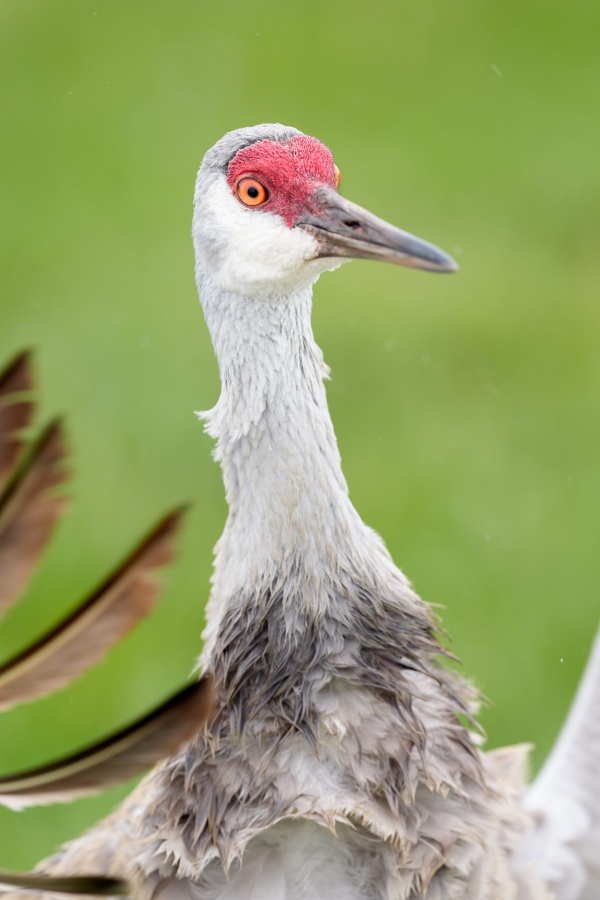
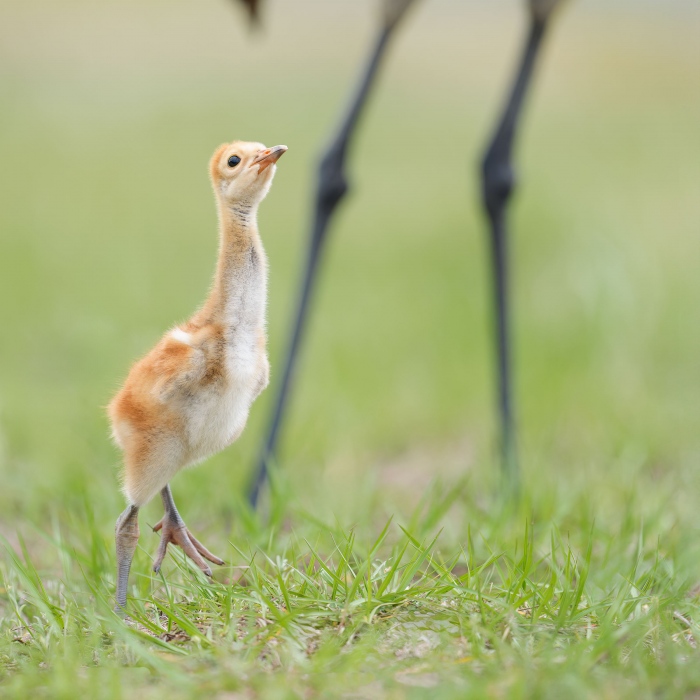
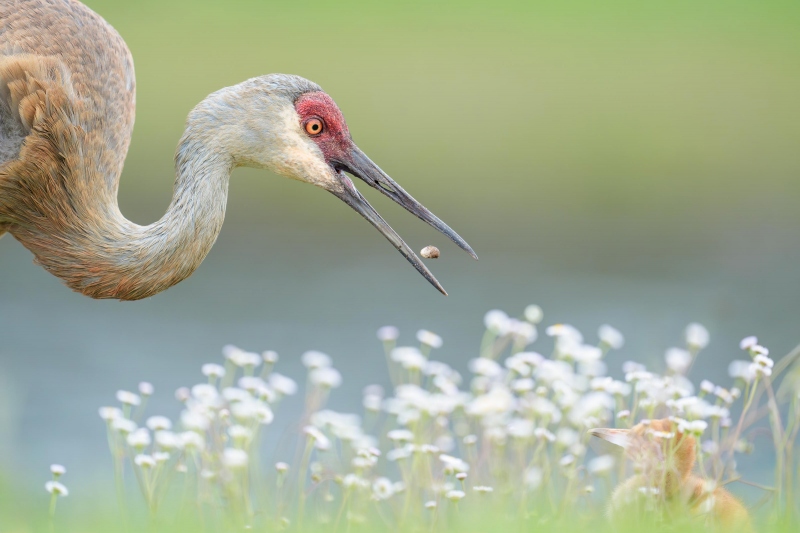
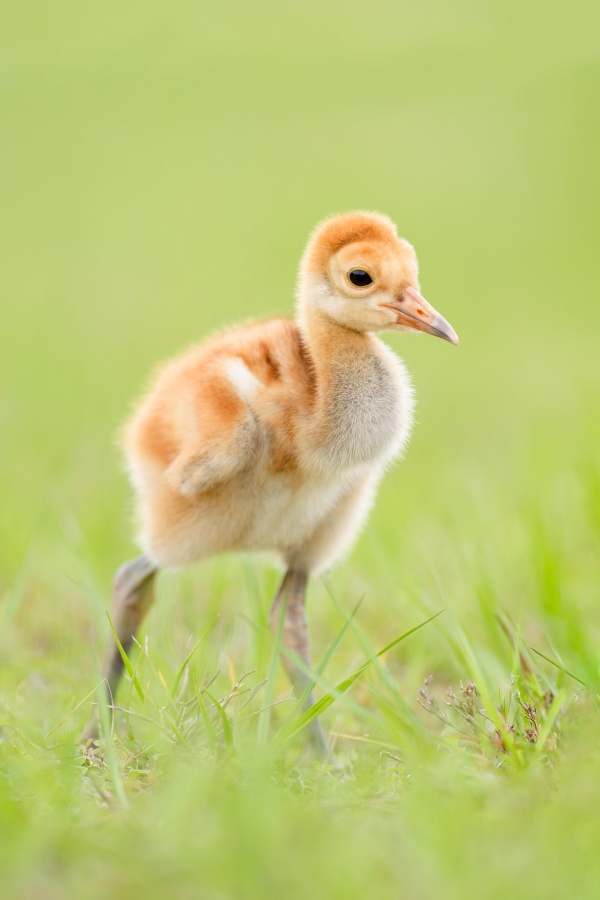
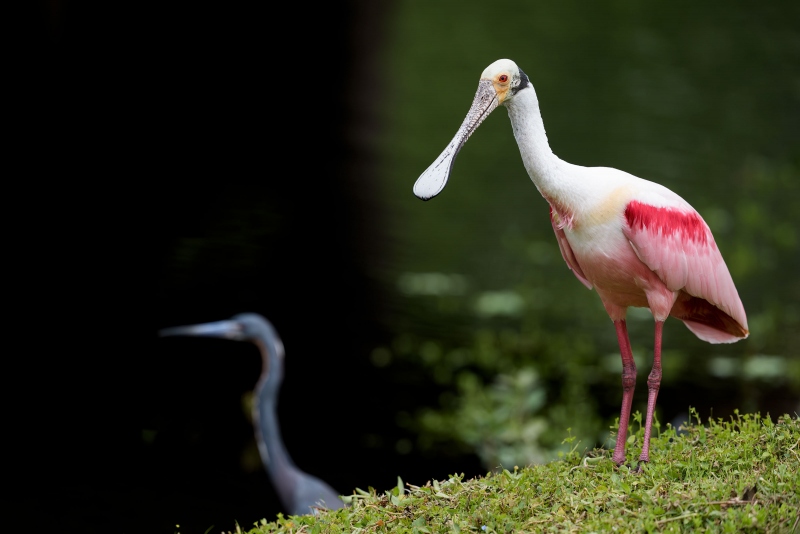
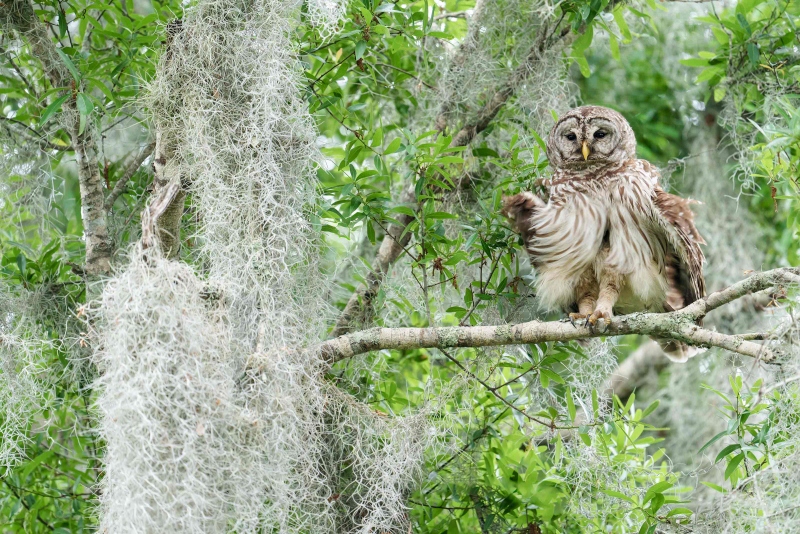
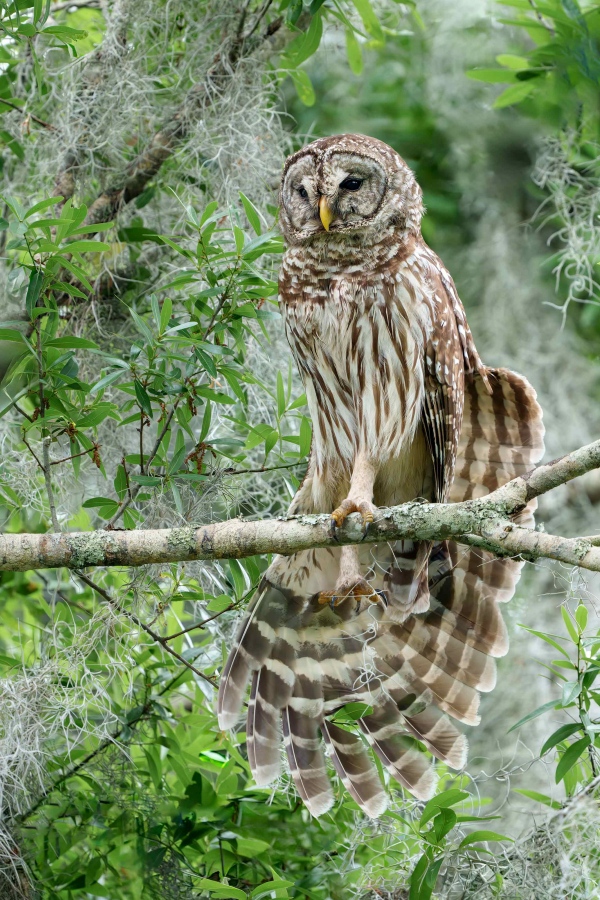
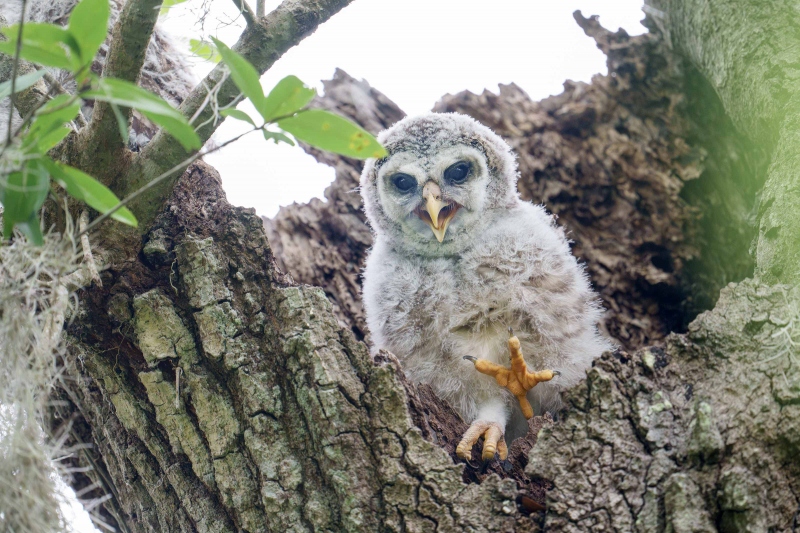
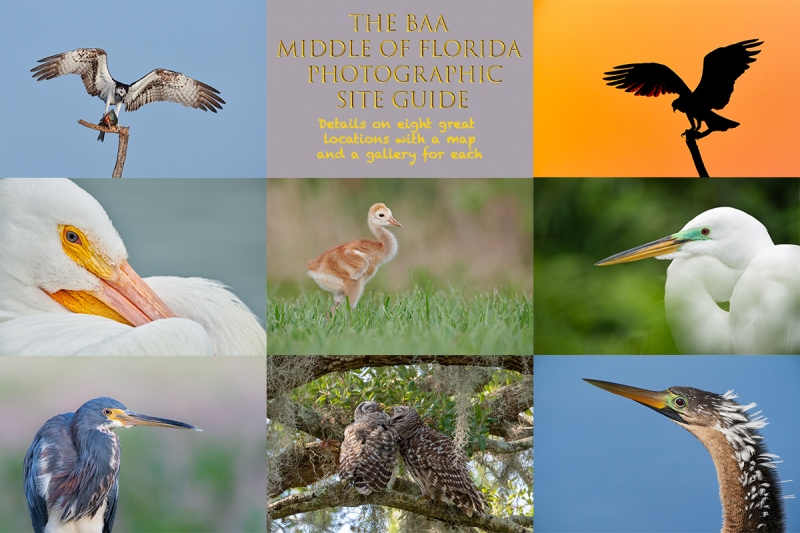













LOL 🙂
Always with love b
I agree with you, Artie. I like the yawning owlet with raised foot best.
Tanks, David.
a
All good/great. The one with the heron and funky background looks like something I might do so non-Artie like. That Spoonbill is sweet looking though. Keep ’em coming we’ll keep loving them.
I will keep trying 🙂
a
#6 Barred Owl is my favorite. I would’ve selected #3 if the eye of the chick was little more visible through the vegetation.
Thanks, Moe. I was mentally begging the chick to reach for the snail and the other tidbits …
with love, a
Artie
I love 6-7-8 the Owls do it for me as one cannot find them readily nor get amazing shots like these. #8 with the mouth open and foot raised is really sweet and my clear choice.
#3 is a clear winner with the comp and the bit of food in air and the sweet little chick waiting below tells the story. Award winner Artie.
#4 The stand alone chick is sweet and adorable and really beautiful overall.
#2 however i feel the shot and the tall sticks 🙂 as Maggi calls them 🙂 are really sweet what bothers me is the black blob above the chicks head as that draws my attention over the amazing photo.
#8 Amazing #6 my 2nd and #7 mom giving out a stretch is sweet as well
#3 the best overall on Sandhills i think you have ever done IMO.
Always with love b
Thanks East Bobman!
The black “blob” above the chick is the adult’s tail. I thought about eliminating it but decided not to. If I had known that you did not like it I would have Removed Tooled it out of existence.
much love, a
#3 is my favorite – what a cracking shot!
In order of preference…. Apologies for lengthy (Sue-ish) response, but with so many great images, I could not resist!
Image 3; Brilliant, an award winner imho.
Image 1: A bit different and soooo sharp!
Image 7: Interesting shot, showing the marvellous plumage with few distractions.
Image 4: “Well captured, cute” image that you’re so good at, but is it better than any of your other cute shots of Sandhill chicks?
Image 8; Great shot of owlet, but that leaf really annoys me!
Image 2; Chick pose is great, but does not seem quite sharp to me, also anyone not knowing might be confused by the two adjacent vertical ‘sticks’! To most the story is obvious…
Image 6: Well captured pose, but seems to get lost in the frame and again, not many non-birding folk would know about ruffling, could be just windswept….
Image 5: Really stunning portrait of the Spoonbill, but, oh dear… that background? I know it is ‘as was’, but looks like an image-editing disaster! I would crop out the whole of the left third of the image, eliminating most of the black background, including the Heron (sorry), and then clone some of the green foliage into the remaining area of black background. It’s defeating the object of the original shot I know, into just a splendid portrait of the single bird.
Thanks, Maggi.
#1 — sharp on the eye where it needed to be with just the right amount of wing blur.
#7 — wait till you see what the original looks like. Here, soon.
#8 — I actually love the leaf.
#4 — is pretty darned good but surly not my best chick shot.
#2 — is razor sharp. There is, however, something funky about the eye that makes it look a bit soft, but it ain’t 🙂
#5 — we disagree. See my comments in the next blog post.
a
A plethora of subjects at hand while shooting in what sounds like less-than-ideal conditions. Of the images presented, I think image #3 is the best for its composition, uniqueness, color, flow, etc.
Tanks, Adam.
a